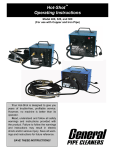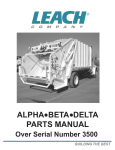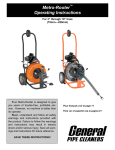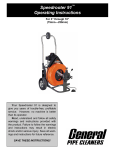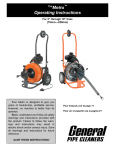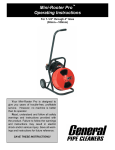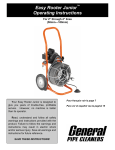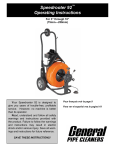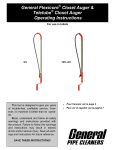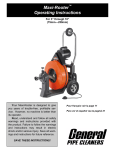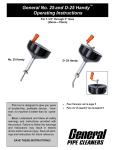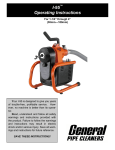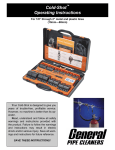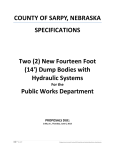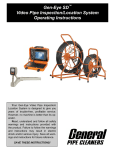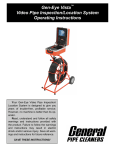Download Rodrunner - General Pipe Cleaners
Transcript
Gasoline-Powered Model ‘E’ Rodrunner™ Operating Instructions For 3” through 10” (75mm—250mm) Your Model ‘E’ Rodrunner is designed to give you years of trouble-free, profitable service. However, no machine is better than its operator. Read, understand and follow all safety warnings and instructions provided with the product. Failure to follow the warnings and instructions may result in electric shock and/or serious injury. Save all warnings and instructions for future reference. SAVE THESE INSTRUCTIONS! Model ‘E’ Rodrunner™ GENERAL SAFETY RULES Machine is designed for outdoor use. Only use indoors in extremely well-ventilated areas. Engine exhaust fumes may cause asphyxiation if allowed to collect in a confined space. WARNING! Read and understand all instructions. Failure to follow all instructions listed below may result in electric shock, fire and/or serious personal injury. Replacement manuals are available upon request at no charge, or may be downloaded from our website, www.drainbrain.com. Instructional videos are available for download on our website, and may be ordered. If you have any questions or problems, please call General’s customer service department at 412-771-6300. Do not add fuel when the machine is operating - risk of fire. Do not spray flammable liquids - risk of explosion. Flammable liquids can create fumes which can ignite causing property damage or severe injury. Do not operate power tools in explosive atmospheres, such as in the presence of flammable liquids, gases, or dust. Power tools create sparks which may ignite the dust of fumes. SAVE THESE INSTRUCTIONS! These instructions are intended to familiarize all personnel with the safe operation and maintenance procedures for the Model ‘E’ Rodrunner. Only wear leather gloves. Never use any other type of glove, such as cloth, rubber, or coated gloves. Never grasp a rotating cable with a rag. These items could become wrapped around the cable and cause serious injury. This is the safety alert symbol. It is used to alert you to potential personal injury hazards. Obey all safety messages that follow this symbol to avoid possible injury or death. Always wear safety glasses and rubber soled, non-slip shoes. Use of this safety equipment may prevent serious injury. DANGER indicates a hazard with a high level of risk which, if not avoided, will result in death or serious injury. Never operate machine with belt guard removed. Fingers can get caught between belt and pulley. WARINING indicates a hazard with a medium level of risk which, if not avoided, could result in death or serious injury. Do not overstress cables. Overstressing cables may cause twisting, kinking, or breaking of the cable and may result in serious injury. CAUTION indicates a hazard with a low level of risk which, if not avoided, will result in minor or moderate injury. 2 Model ‘E’ Rodrunner™ GENERAL SAFETY RULES 6. Check for misalignment or binding of moving parts, breakage of parts, and any other condition that may affect the tool’s operation. If damaged, have the tool serviced before using. Many accidents are caused by poorly maintained tools. 7. Only use accessories that are recommended by the manufacturer for your model. Accessories that may be suitable for one tool may become hazardous when used on another tool. 8. Allow engine to cool for 2 minutes before refueling. If any fuel is spilled, make sure the area is dry before testing the spark plug or starting the engine. Fire and/or explosion may occur. 9. Gasoline engines on mobile or portable equipment shall be refueled: A) outdoors, B) With the engine on the equipment stopped; C) With no source of ignition within 1o feet of the dispensing point; and D) With an allowance made for expansion of the fuel should the equipment be exposed to a higher ambient temperature. In an overfilling situation, additional precautions are necessary to ensure that the situation is handled in a safe manner. Work Area 1. Keep work area clean and well lit. Cluttered benches and dark areas invite accidents. 2. Do not operate power tools in explosive atmospheres, such as in the presence of flammable liquids, gases, or dust. Power tools create sparks which may ignite the dust or fumes. 3. This machine is designed for outdoor use. It can be used indoors only in an extremely well-ventilated area. Engine exhaust fumes may cause asphyxiation if allowed to collect in a confined area. 4. Keep bystanders, children, and visitors away while operating a power tool. Distractions can cause you to lose control. 5. Do not place machine near flammable objects. The engine may be hot and could ignite these objects. Personal Safety 1. Stay alert, watch what you are doing and use common sense when operating a power tool. Do not use tool while tired or under the influence of drugs, alcohol, or medication. A moment of inattention while operating power tools may result in serious personal injury. Service 2. Dress properly. Do not wear loose clothing or jewelry. Contain long hair. Keep your hair, clothing, and gloves away from moving parts. Loose clothes, jewelry, or long hair can be caught in moving parts. 1. Tool service must be performed only by qualified repair personnel. Service or maintenance performed by unqualified repair personnel could result in injury. 3. Avoid accidental starting. Be sure switch is off before plugging in. Plugging in tools that have the switch on invites accidents. 2. When servicing a tool, use only identical replacement parts. Follow instructions in the Maintenance section of this manual. Use of unauthorized parts or failure to follow Maintenance Instructions may create a risk of electric shock or injury. 4. Remove adjusting keys or switches before turning the tool on. A wrench or key that is left attached to a rotating part of the tool may result in personal injury. SPECIFIC SAFETY RULES 1. 5. Do not overreach. Keep proper footing and balance at all times. Proper footing and balance enables better control of the tool in unexpected situations. 6. Use safety equipment. Always wear eye protection. Dust mask, non-skid safety shoes, hard hat, or hearing protection must be used for appropriate conditions. 2. 3. Tool Use and Care 1. Use clamps or other practical way to secure and support the workpiece to a stable platform. Do not force tool. Holding the work by hand or against your body is unstable and may lead to loss of control. 4. 5. 2. Do not force tool. Use the correct tool for your application. The correct tool will do the job better and safer at the rate for which it is designed. 3. Do not use tool if switch does not turn it on or off. Any tool that cannot be controlled with the switch is dangerous and must be repaired. 6. 4. Store idle tools out of reach of children and other untrained persons. Tools are dangerous in the hands of untrained users. 7. 5. Maintain tools with care. Keep cutting tools sharp and clean. Properly maintained tools, with sharp cutting edges are less likely to bind and are easier to control. 8. 3 Only wear leather gloves. Never use any other type of glove, such as cloth, rubber, or coated gloves. Never grasp a rotating cable with a rag. These items could become wrapped around the cable and cause serious injury. Never operate machine with guard removed. Fingers can get caught in mechanism. Do not overstress cables or rods. Keep leather-gloved hand on the cable for control when machine is running. Overstressing cables because of an obstruction may cause twisting, kinking, or breaking of the cable and may result in serious injury. Machine is designed for ONE-PERSON operation. Operator must control foot switch and cable. Be careful when cleaning drains where cleaning chemicals have been used. Avoid direct contact with skin and eyes. Drain cleaning chemicals can cause serious burns as well as damage the cable. Do not operate machine if operator or machine is standing in water. Will increase risk of electrical shock. Wear safety glasses and rubber soled, non-slip shoes. Use of this safety equipment may prevent serious injury. Before starting each job, check that the cable in is not broken or kinked, by checking for wear or breakage. Always replace worn out (kinked or broken) cables with genuine GENERAL replacement cables. Model ‘E’ Rodrunner™ 9. ASSEMBLY Only use this tool in the application for which it was designed. Follow the instructions on the proper use of the machine. Other uses or modifying the drain cleaner for other applications may increase risk of injury. The Rodrunner Model E is completely assembled except for attaching the handle to the machine frame and the transmission lever to the transmission. TO ATTACH THE HANDLE: 1. Remove the equipment from the packaging. 2. Take the four cap screws and nuts from the tool box for attaching the handle. 3. Being careful not to kink the throttle cable, slide the handle backward into position and install one cap screw in each side. The shorter cap screws go into the upper holes, while the longer cap screws go into the lower holes with the lower nuts being installed unexposed beneath the machine base. Be careful to protect the throttle cable from damage while manipulating the handle. 4. Install nuts and tighten. 5. Check operation of the throttle. It should move freely in and out. FEATURES Throttle Control “Hot-Shift” Transmission Lever Guard Engine Pull Start Cord TO ATTACH THE “HOT-SHIFT” LEVER TO THE TRANSMISSION: 1. Remove the 1/4-20 x 1” cap screw and locknut from the 5/8” diameter bar projecting up from the transmission. 2. Remove the wrapping from the transmission shifting lever and slide it down onto the bar. 3. Insert the cap screw through the hole and apply the locknut. Detachable Handle Cable OPERATION Cutter Application Chart Cutter Spear Head Hook Auger 2" UCutter 3" Heavy Duty Side Cutter 3" Heavy Duty Saw Blade 4" Rotary Saw Blade Retrieving Tool Catalog # “G” “L” Conn. Conn. MAKE SURE THE MOTOR IS NOT RUNNING Typical Applications Starting tool, gets the water flowing G-SHD L-SHD G-HA L-HA Starting tool, to remove loose objects. G-2UC L-2UC Starting tool, for cutting and scraping. G-3HDSC L-3HDSC The Model ‘E’ is furnished with two driving chucks, one for Municipal Rods: Finishing tool, for scraping inside edges of pipe. Heavy duty tool for cutting roots. G-3HDB L-3HDB G-4RSB L-4RSB For cutting roots. G-RTR-2 For removing loose L-RTR-2 objects and broken cables. and one for Sectional Cables: Note: There are not fixed rules for what cutter to use. If one tool doesn’t take care of a stoppage, simply try another. 4 Model ‘E’ Rodrunner™ The Municipal Rod “No-Wrench Chuck” slips over the spindle and is secured by tightening two set screws onto flats on the spindle. Make sure the set screws are tightened onto the flats. Before attempting to install the No-Wrench Chuck, be sure that the two set screws in the spindle do not project above the shaft surface or the No-Wrench Chuck will not slide on. 4. When you have pushed as much cable into the line as you can, slide the back of the last section through the guide tube on the machine and attach it to the cable drive coupler. 5. There should be water in the line to provide lubrication and cooling for the cable. The No-Wrench Sectional Cable Chuck slips into the spindle and is secured by tightening the two spindle set screws onto the flats on the chuck shaft. Make sure the set screws are tightened onto the flats. 6. Start the engine and carefully engage the clutch in the forward direction. Operate the engine at the slowest speed. 7. Begin moving the machine forward. Advance slowly. Let the cable do the work without forcing. Do not push the machine faster than the cable feeds into the line. This may cause the cable to whip and kink. SETTING SLIP CLUTCH The slip clutch is factory set at 20 foot pounds. primarily to protect the cable sections. When municipal rods are used, the torque setting may be increased. However, when switching to cable sections, return the torque adjustment to its original position to prevent damage to the cables. DO NOT ALLOW TOO MUCH SLACK IN THE CABLE BETWEEN MACHINE AND DRAIN OPENING SINCE THIS CAN CAUSE CABLE WHIPPING. The back of the tube that the sections run through is threaded. Screwed onto this tube is a collar that presses against a spring that maintains pressure on a clutch face. TO INCREASE OR DECREASE CLUTCH SLIPPAGE: Loosen the screw in the collar and turn the collar until you obtain the desired tension. Then, tighten the screw into the collar. It is a good idea to measure and record the distance between the threaded end of the spindle and the slip clutch adjusting nut for future reference. Remember that the clutch is put on the machine to protect your cables! Therefore, don’t tighten to the point where sections will be damaged before the clutch slips. Be sure that there is gasoline in the tank and that the grounding switch on the spark plug is OPEN. 3. Pull out the choke and pull the starter cord until the engine starts. 4. Immediately but gradually adjust the choke to the fully closed position as is necessary to maintain smooth operation. This may take a minute or two in cold weather – much less time in warmer weather. 2. Push this section into the line until you meet resistance. It might be possible to feed more than one section into the line in this way. 3. When linking additional sections, be sure that the connector locking pin snaps firmly into place. Turn the locking ring until there is a distinct “click”. When all but the last two feet of the cable have been fed into the line, shut down the machine, disconnect the cable from the cable chuck, and back the machine up approximately ten feet. 11. Repeat this procedure until you’ve worked through the stoppage. DO NOT USE TOO MUCH FORCE – LET THE CUTTER DO THE WORK. 12. Run the machine in reverse to pull the sections out of the line. If the cutter gets caught, run the machine in forward rotation and pull back until it is clear. Then, resume reverse rotation. MAKE SURE THE MOTOR IS NOT RUNNING Lay out a cable section and attach a Spear Head Cutter to the front. 9. 10. Lay down another section, connect the female end to the section in the line, and the male end to the cable chuck. OPERATION WITH SECTIONAL CABLES 1. Once the cable has begun feeding itself into the line, it may be possible to increase the engine speed without causing whipping. Note: If a section is not feeding through a trap or bend, it may be necessary to have an assistant use the optional Cable Feeding Tool (Cat. # CF). The tool is used to press the cable against the drain opening so that the cable can work itself around the bend. STARTING AND STOPPING THE ENGINE 1. Place the transmission lever in “NEUTRAL”. 2. 8. 13. After breaking through the stoppage and water is running through the line, you can use a larger cutter to clean the line more thoroughly. 5 Model ‘E’ Rodrunner™ ENGINE MAINTENANCE OPERATION WITH MUNICIPAL RODS Consult the maintenance information furnished by the engine manufacturer. This information is included in your packet. 1. Check oil level after each 5 hours of operation. Do not check while the engine is running. MAKE SURE THE MOTOR IS NOT RUNNING 1. 2. 3. 4. 5. Attach one of the smaller cutters, such as the Diamond Head, to the first rod. Connect several rods, and start feeding them into the line until resistance is met. Add about five more sections, then slide the rear section through the guide tube on the machine and connect it to the No-Wrench Chuck. Do not have more than twenty feet of rods between the machine and the pipe opening. Change oil after the first five hours of operation. Thereafter, change the oil after every twenty-five hours of operation. 3. Use a good grade of 10W-40 automotive engine oil. The engine has been filled with oil prior to shipment. GEAR REDUCER MAINTENANCE Drain and change the oil every one hundred hours of operation. Use a good grade of 10W-40 automobile engine oil. Start the engine and put the transmission in the forward direction at a slow speed. Be sure you’re running slow enough to avoid whipping. Begin moving the machine ward. Move forward only as as the cutter clears the line. the cutter do the work; do force it. 2. forfast Let not 1. Remove both “level-plugs” to refill. 2. Fill until the oil runs out of the level hole. 3. Replace plugs, making sure that the oil “fill-plug”, which has a vent hole, is installed on the top of the gear case cover. AIR FILTER MAINTENANCE Clean and re-oil the foam element at three month intervals, or every twenty-five operating hours, whichever occurs first. Use SAE-30 oil. THROTTLE LINKAGE MAINTENANCE Keep the throttle linkage clean and free of dirt and/or corrosion. Lubricate after each ten hours of use with a cleaner/lubricator, such as WD -40. TRANSMISSION/CLUTCH MAINTENANCE Consult maintenance information furnished by the transmission manufacturer. This information is included in your packet. DO NOT USE TOO MUCH FORCE – LET THE CUTTER DO THE WORK. 6. Add more rods as required to reach the stoppage. 7. When the stoppage has been cleared, pull the machine backward, but continue to run the machine in the forward direction. The forward and the reverse clutch should be adjusted so there is no spindle movement in the neutral position, and the shift lever locks into position at either side but can be bumped readily with the hand to the neutral position. Hint: The machine can be reversed quickly because of the “HotShift” transmission. If an obstacle is encountered, the machine can be run alternatively in forward and reverse to free the cutter. However, do not attempt to move the rod forward while the machine is driving in the reverse direction. MAINTENANCE 1. Drain and refill the transmission after the first thirty hours of operation. Thereafter, replace the oil after one hundred hours of operation or every six months, whichever occurs first. 2. Use a good grade of SAE-30, non-detergent oil above 32˚ F. Below 32˚ F, use SAE-10 oil. 3. Be sure the unit is filled to the oil level hole. DRIVE CHAIN MAINTENANCE The roller chain is “lifetime lubricated”. It is desirable, however, to apply about ten drops of SAE-30 oil to the chain after every twentyfive to thirty hours of operation. MAKE SURE MOTOR IS NOT RUNNING BEFORE PERFORMING MAINTENANCE ON MACHINE! To keep your machine operating smoothly, it is essential that all bearings and bushings be lubricated. Oiling moving parts is particularly important where machine comes in contact with sand, grit and other abrasive material. DRIVING SPINDLE MAINTENANCE After each twenty-five hours of operation, lift the plastic guard and add several drops of oil to the oil hole in the spindle housing. CABLE MAINTENENCE To get maximum service from your cables, be sure that they are clean and well oiled. This not only provides running lubrication but greatly extends the life of the cables as well. Our SNAKE OIL is ideally suited for this purpose, since it not only lubricates the cables, it deodorizes them as well. 6 Model ‘E’ Rodrunner™ MODEL "E" GAS RODRUNNER PARTS LIST CAT. NO. RDE-100 RDE-101 RDE-101-A RDE-102 RDE-102-A RDE-106 RDE-107-1 RDE-107-A RDE-108 RDE-108-A RDE-109 RDE-109-1 RDE-109-A RDE-200 RDE-200-1 RDE-201 RDE-201-A RDE-201-B RDE-202 RDE-220 RDE-221 RDE-221-1 RDE-222 RDE-223 RDE-223-1 RDE-223-1-A RDE-223-1-B RDE-224 DESCRIPTION Frame Complete Base Only w/Axles Axle (1) Guide Bolts, Nuts & Washers Handle Pneumatic Tire (1) Hat-Type Push Nut (4) Engine Coupling Guard Screws for Coupling Guard (4) Chain Guard (100-200 RPM) Chain Guard (200-400 RPM) Screws for Gear Guard (5) Drive Assembly (100-200 RPM) Drive Assembly (200-400 RPM) Bearing Housing Rear Ball Bearing Front Bronze Bushing Bolts & Washers CAT. NO. RDE-225 RDE-226 RDE-227 RDE-228 RDE-229 RDE-229-1 RDE-230 RDE-301 RDE-302 RDE-302-1 RDE-303 RDE-303-1 RDE-310 RDE-315 RDE-315-A RDE-320 RDE-320-A RDE-325 RDE-326 Drive Shaft Pressure Plate (1) w/Set Screws (2) (100-200 RPM) Pressure Plate (200-400 RPM) Friction Disc Drive Sprocket (100-200 RPM) Drive Sprocket (200-400 RPM) Screw (2) (200-400 RPM) Roll Pin (2) (200-400 RPM) Thrust Bearing Set RDE-330 RDE-330-A RDE-330-B RDE-330-C E-MRDC E-GCDC E-LCDC TB-RDE DESCRIPTION Tension Spring Tension Adjusting Colar w/Screw Snap Rings (2) Square Head Set Screw & Lock Nut Spacer (100-200 RPM) Spacer (200-400 RPM) Bushing (200-400 RPM) 205cc 4 Stroke Engine Drive Sprocket (100-200 RPM) Drive Sprocket (200-400 RPM) Drive Chain (100-200 RPM) Drive Chain (200-400 RPM) Throttle Cable - Discontinued Throttle Control Assembly Mounting Screws (2) Engine Coupling Coupling Sleeve Hot Shift Transmission Bolts, Nuts, Washers, Small Spacers & Large Spacers (4) Transmission Control Handle Control Handle Knob Set Screw Bolt & Nut Municipal Rod Drive Coupling Drive Coupling for "G" Cables Drive Coupling for "L" Cables Tool Box OPTIONAL ACCESSORIES FOR MODEL ‘E’ RODRUNNER Optional Cable Feeding Tool (Cat. # CF) Optional Wheeled Cable Carrier (Cat. # WCC) Holds five 10-foot sections. Optional Cable Carrier (Cat. # CC) Holds five 10-foot sections. 7 Model ‘E’ Rodrunner™ General Wire Spring Co, 1101 Thompson Avenue McKees Rocks, PA 15136 412-771-6300 www.drainbrain.com © General Wire Spring Co. 2010 C-RDOI-0310








